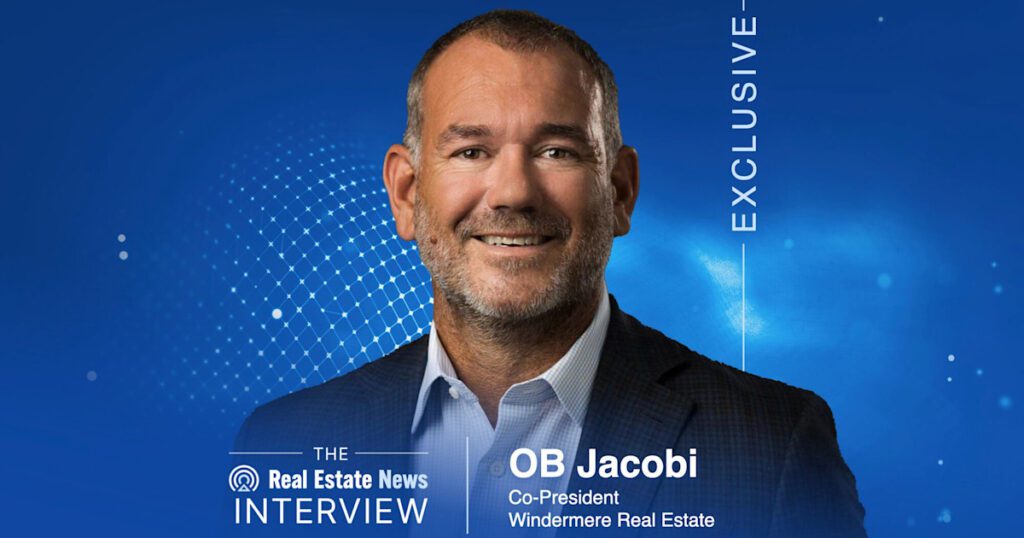Windermere Co-President OB Jacobi explains what goes into an acquisition — including when it does — and doesn’t — make sense for companies to come together.
Key points:
- A tough sales environment has led some companies to seek consolidation or sell to larger brokerages, notes Windermere Co-President OB Jacobi.
- Untangling what an M&A or brand change looks like can take “a really long time,” he said. Regardless of that timeline, cultural and leadership fit are crucial.
- Larger companies also often offer ancillary businesses — like mortgage, title, escrow and insurance — to tap into more revenue and scale.
The real estate brokerage landscape is entering one of its most significant periods of consolidation in decades, shaped as much by leadership decisions and cultural alignment as by balance sheets.
At least that’s the perspective of Windermere Co-President OB Jacobi. Behind every inquiry about a merger or acquisition lies a complex mix of motivations — from owners seeking scale and support in a tough market to those looking for an exit strategy amid shrinking margins and slowing home sales, according to the industry leader.
In a discussion with Real Estate News about the consolidation moment and what goes into brokerage acquisitions, Jacobi shares his thoughts about what’s fueling the current M&A environment and why culture often still trumps economics while scaling up.
Market pressure driving consolidation wave
After three years of what Jacobi bluntly described as a “shitty” market in which home sales are down and agents are struggling, many brokerages are looking for lifelines.
A year ago, some broker-owners sold to bigger firms to seek coverage under the NAR settlement. But most calls these days come from firms that feel too small to compete or are struggling with profitability — or from owners who are simply ready to retire, Jacobi said.
“With markets that are really hard, a bunch of things happen. Some retire early and others get out of the business because they’re not making it,” he explained. “If you’re an office of 50, and you see a shift of 10, your economics have changed drastically. So you might call us and say, ‘I’ll merge with you because there’s economies of scale in joining a company.'”
Leadership alignment is make-or-break in the M&A equation
Any merger or acquisition is also heavily dependent upon cultural fit and leadership support. The process of “trying to figure out what that merger or acquisition or brand change looks” like can take “a really long time” for a variety of reasons, Jacobi noted. But figuring out how the end result will function and who will remain involved is equally important from an economic standpoint.
“Where it gets a lot harder for us — and I think this is typical for the whole industry — is, who is the current leadership and what is their plan going forward? Are they supportive of this change? Are they staying around? Do they have a long-term earn-out? Making sure that there’s a strong leadership component to that switch over is critically important,” he said.
Culture clashes can doom attractive deals
It’s common for brokerage leaders to highlight shared values and goals when announcing new acquisitions or affiliations. But how much does this really matter?
Quite a bit, according to Jacobi. “Cultural fit is actually a real thing,” he said. “We have certainly had calls from people and have been — I guess the right word would be ‘scared’ — away from doing something with them.”
Windermere once “walked away from a highly profitable deal” with a Canadian company that had several thousand agents, a flat fee structure and little to no service to brokers. That decision was made because “it wasn’t the right fit for our company,” Jacobi explained. The other firm’s model “just didn’t fit” with what Windermere represents, he added.
Big brokerages can offer tangible benefits
When cultural and leadership stars align, a pitch from a larger company can be pretty straightforward in terms of the benefits a smaller broker or team can expect. Larger regionals can offer ancillary businesses — like mortgage, title, escrow and insurance — to help smaller firms tap into more revenue and scale.
Larger firms also often offer professional development and other resources — it’s like having “a community of people you can rely on,” Jacobi said.


